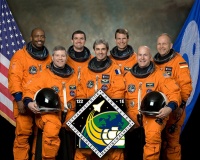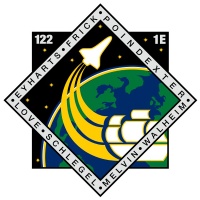STS-122
From The Space Library
 | |
| Organization | NASA-Office of Space Flight (United States) |
|---|---|
| Mission type | Human Crew,Resupply/Refurbishment/Repair |
| Launch date | February 7, 2008 |
| Launch vehicle | Space Shuttle |
| Launch site | Cape Canaveral, United States |
| COSPAR ID | 2008-005A |
| Inclination | 51.6 degrees |
| Experiments | Here |
| Alternate Names | 32486 |
| Additional Information | Here |
| Data Collection | Here |
| Payload Mass Up | 14941.78 kg |
| Payload Mass Down | 2636.36 kg |
| Orbiter | Atlantis |
| Lift Off Mass | 2,056,023.64 kg |
| Orbiter Weight at Liftoff | 121,402.27 kg |
| Orbiter Weight at Landing | 93,787.73 kg |
| Landed | 9:07 a.m. EST, concrete runway 15, Kennedy Space Center, Fla. |
| Orbits of Earth | 202 |
| Orbital Altitude | Approximately 185 nautical miles |
Contents |
[edit] Crew
- Commander: Stephen N. Frick
- Pilot: Alan G. Poindexter
- Payload Commander:
- Mission Specialist 1: Rex J. Walheim
- Mission Specialist 2: Stanley G. Love
- Mission Specialist 3: Leland D. Melvin
- Mission Specialist 4: Hans Schlegel, European Space Agency (ESA)
- Mission Specialist 5:
- Payload Specialist 1:
- Payload Specialist 2:
ISS/Mir Crew Transport
- Leopold Eyharts, ESA - up only Daniel M. Tani - down only
[edit] Mission
STS 122 is an American shuttle craft that was launched from Cape Canaveral at 19:45 UT on 07 February 2008. It carried seven astronauts (five American and two European) to the International Space Station (ISS). The primary goal of the mission was to carry the European (ESA) laboratory, Columbus, to the ISS and install it. It docked with the ISS at 17:25 UT on 09 February. The Columbus laboratory is 6.8 m long, with a diameter of 4.5 m, volume of 75 3 and mass of 12.8 tonnes, and contains four ESA science instruments racks and one storage rack. Later, NASA will add five more racks. The laboratory was connected to the Harmony module (that was installed during the STS 120 mission) of the ISS, and is expected to be used for microgravity science projects. The crew did three spacewalks to install and checkout the connections. They also installed on Columbus a European solar monitor named SOLAR, and a facility named EuTEF (European Technology Exposure Facility). The shuttle undocked from the ISS at 09:28 UT on 18 February, and landed back at Cape Canaveral at 14:08 UT on 20 February.
[edit] EVA
Extravehicular Activity (EVA) conducted by Rex Walheim, Stanley Love, and Hans Schlegel during three spacewalks for a total of 22 hours, 8 minutes. EVA 1, 7 hours, 58 minutes; Walheim and Love installed a grapple fixture on Columbus while it rested inside the shuttle's payload bay and prepared electrical and data connections on Columbus. Leland Melvin, Dan Tani, and Leopold Eyharts operated the space station's robotic arm to grapple Columbus, lift it out of the orbiter, and attach it to the Harmony module on the starboard side of the ISS. EVA 2, 6 hours, 45 minutes; Walheim and Schlegel swapped out a 550-pound nitrogen tank used to pressurize ammonia through the station's main cooling system. EVA 3, 7 hours, 25 minutes; Walheim and Love transferred a failed gyroscope to the shuttle's payload bay for return to Earth, installed an observatory to the Columbus module called SOLAR to monitor the sun, and installed an experiment to the outside of Columbus, the European Technology Exposure Facility (EuTEF). This experiment will allow scientists to expose experiments to the vacuum and elements of space.
[edit] Payload
ISS Assembly Flight 1E; Columbus Laboratory; crew exchange
[edit] Books about the Space Shuttle Program
Buy This Book Click here |
Buy This Book here |
Buy This Book Click here |
Buy This Book Click here |





